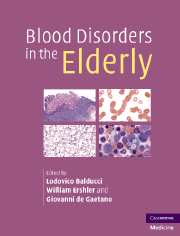Book contents
- Frontmatter
- Contents
- List of contributors
- Preface
- Part I Epidemiology
- Part II Hematopoiesis
- Part III Anemia of aging
- Part IV Hematologic malignancies and aging
- Part V Disorders of hemostasis in the elderly
- 26 Acquired hemophilia in the elderly
- 27 Blood coagulation and aging
- 28 Platelet disorders in the elderly
- 29 Gene—environment interactions and vascular risk in the elderly
- 30 Antithrombotic therapy: guidelines for the elderly
- Index
27 - Blood coagulation and aging
from Part V - Disorders of hemostasis in the elderly
Published online by Cambridge University Press: 21 October 2009
- Frontmatter
- Contents
- List of contributors
- Preface
- Part I Epidemiology
- Part II Hematopoiesis
- Part III Anemia of aging
- Part IV Hematologic malignancies and aging
- Part V Disorders of hemostasis in the elderly
- 26 Acquired hemophilia in the elderly
- 27 Blood coagulation and aging
- 28 Platelet disorders in the elderly
- 29 Gene—environment interactions and vascular risk in the elderly
- 30 Antithrombotic therapy: guidelines for the elderly
- Index
Summary
Introduction
The incidence of thrombotic complications increases with age. This is the case not only for arterial disease, in which thrombotic occlusion is the major complication of an unstable atherosclerotic plaque, but also for venous thromboembolism. Indeed, the risk of venous thrombosis increases sharply with age, from roughly 1 per 10 000 people per year before age 40 to 1 in 100 per year for those over age 75 years. The purpose of this chapter is to describe the pathophysiology of blood coagulation and to attempt to identify the changes associated with aging.
The pathophysiology of blood coagulation
Blood coagulation plays a fundamental role in the arrest of bleeding. When a vessel is severed, blood loss is stopped by the development within the wound of a “hemostatic plug” consisting of tightly packed platelets held together by fibrin fibers. The coagulation process refers to the formation of these fibrin fibers. Whereas this physiologic response to trauma mainly takes place within the vessel wall and around the damaged vessel, the same process may occur pathophysiologically within the vessel lumen, when for instance the endothelium is disrupted. The plug then no longer has a hemostatic function, but potentially encroaches on the flow of blood; this intravascular plug is called a thrombus and again consists of cellular elements (platelets, leukocytes, and red cells) held together by fibrin. We shall now discuss how insoluble fibrin fibers are formed.
- Type
- Chapter
- Information
- Blood Disorders in the Elderly , pp. 406 - 419Publisher: Cambridge University PressPrint publication year: 2007



